Text
George Catlin (July 26, 1796 – December 23, 1872) was an American lawyer, painter, author, and traveler, who specialized in portraits of Native Americans in the American frontier. Traveling to the American West five times during the 1830s, Catlin wrote about and painted portraits that depicted the life of the Plains Indians. His early work included engravings, drawn from nature, of sites along the route of the Erie Canal in New York State. Several of his renderings were published in one of the first printed books to use lithography, Cadwallader D. Colden’s Memoir, Prepared at the Request of a Committee of the Common Council of the City of New York, and Presented to the Mayor of the City, at the Celebration of the Completion of the New York Canals, published in 1825, with early images of the City of Buffalo.

Chief Big Elk - George Catlin, 1832
46 notes
·
View notes
Text
George Catlin (July 26, 1796 – December 23, 1872) was an American lawyer, painter, author, and traveler, who specialized in portraits of Native Americans in the American frontier. Traveling to the American West five times during the 1830s, Catlin wrote about and painted portraits that depicted the life of the Plains Indians. His early work included engravings, drawn from nature, of sites along the route of the Erie Canal in New York State. Several of his renderings were published in one of the first printed books to use lithography, Cadwallader D. Colden’s Memoir, Prepared at the Request of a Committee of the Common Council of the City of New York, and Presented to the Mayor of the City, at the Celebration of the Completion of the New York Canals, published in 1825, with early images of the City of Buffalo.

George Catlins travels in South America 1852-1858
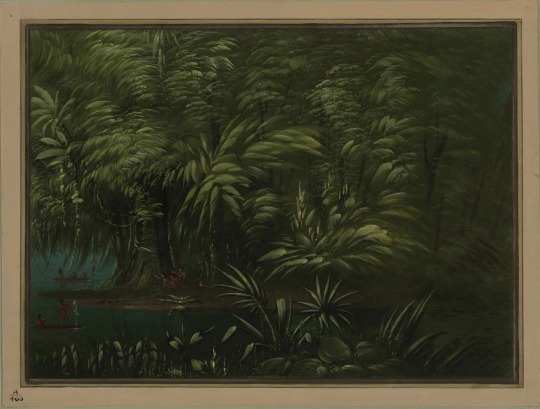
Luxuriant forest on the Bank of the Amazon, above Óbidos, 1854/1869, George Catlin.
18 notes
·
View notes
Photo
George Catlin (July 26, 1796 – December 23, 1872) was an American lawyer, painter, author, and traveler, who specialized in portraits of Native Americans in the American frontier. Traveling to the American West five times during the 1830s, Catlin wrote about and painted portraits that depicted the life of the Plains Indians. His early work included engravings, drawn from nature, of sites along the route of the Erie Canal in New York State. Several of his renderings were published in one of the first printed books to use lithography, Cadwallader D. Colden’s Memoir, Prepared at the Request of a Committee of the Common Council of the City of New York, and Presented to the Mayor of the City, at the Celebration of the Completion of the New York Canals, published in 1825, with early images of the City of Buffalo.
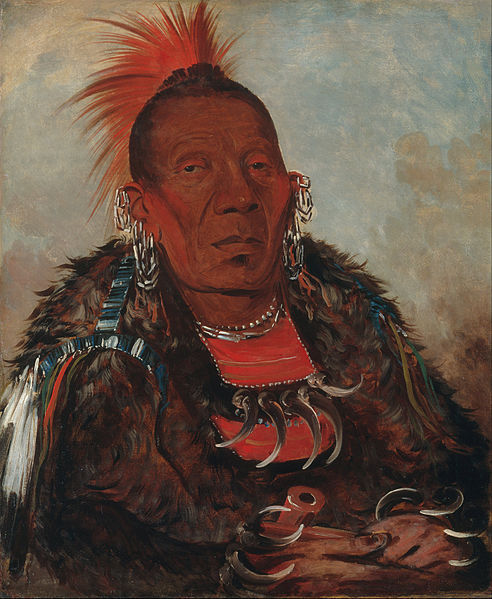
George Catlin, Wah-ro-née-sah, The Surrounder, Chief of the Otoe Tribe - Wikipedia
24 notes
·
View notes
Text
George Catlin (July 26, 1796 – December 23, 1872) was an American lawyer, painter, author, and traveler, who specialized in portraits of Native Americans in the American frontier. Traveling to the American West five times during the 1830s, Catlin wrote about and painted portraits that depicted the life of the Plains Indians. His early work included engravings, drawn from nature, of sites along the route of the Erie Canal in New York State. Several of his renderings were published in one of the first printed books to use lithography, Cadwallader D. Colden’s Memoir, Prepared at the Request of a Committee of the Common Council of the City of New York, and Presented to the Mayor of the City, at the Celebration of the Completion of the New York Canals, published in 1825, with early images of the City of Buffalo.

Medicine Man, Performing His Mysteries Over a Dying Man by George Catlin (1832)
73 notes
·
View notes
Text
George Catlin (July 26, 1796 – December 23, 1872) was an American lawyer, painter, author, and traveler, who specialized in portraits of Native Americans in the American frontier. Traveling to the American West five times during the 1830s, Catlin wrote about and painted portraits that depicted the life of the Plains Indians. His early work included engravings, drawn from nature, of sites along the route of the Erie Canal in New York State. Several of his renderings were published in one of the first printed books to use lithography, Cadwallader D. Colden’s Memoir, Prepared at the Request of a Committee of the Common Council of the City of New York, and Presented to the Mayor of the City, at the Celebration of the Completion of the New York Canals, published in 1825, with early images of the City of Buffalo.

George Catlin, Prairie meadow burning, 1832
36 notes
·
View notes
Text
George Catlin (July 26, 1796 – December 23, 1872) was an American lawyer, painter, author, and traveler, who specialized in portraits of Native Americans in the American frontier. Traveling to the American West five times during the 1830s, Catlin wrote about and painted portraits that depicted the life of the Plains Indians. His early work included engravings, drawn from nature, of sites along the route of the Erie Canal in New York State. Several of his renderings were published in one of the first printed books to use lithography, Cadwallader D. Colden’s Memoir, Prepared at the Request of a Committee of the Common Council of the City of New York, and Presented to the Mayor of the City, at the Celebration of the Completion of the New York Canals, published in 1825, with early images of the City of Buffalo.

Ni-a-có-mo, Fix With the Foot, a Brave, George Catlin, 1830
129 notes
·
View notes
Text
George Catlin (July 26, 1796 – December 23, 1872) was an American lawyer, painter, author, and traveler, who specialized in portraits of Native Americans in the American frontier. Traveling to the American West five times during the 1830s, Catlin wrote about and painted portraits that depicted the life of the Plains Indians. His early work included engravings, drawn from nature, of sites along the route of the Erie Canal in New York State. Several of his renderings were published in one of the first printed books to use lithography, Cadwallader D. Colden’s Memoir, Prepared at the Request of a Committee of the Common Council of the City of New York, and Presented to the Mayor of the City, at the Celebration of the Completion of the New York Canals, published in 1825, with early images of the City of Buffalo.
When Catlin returned east in 1838, he assembled the paintings and numerous artifacts into his Indian Gallery, and began delivering public lectures that drew on his personal recollections of life among the American Indians. Catlin traveled with his Indian Gallery to major cities such as Pittsburgh, Cincinnati, and New York City. He hung his paintings salon style, side by side and one above another. Visitors identified each painting by the number on the frame, as listed in Catlin's catalogue. Soon after, he began a lifelong effort to sell his collection to the U.S. government. The touring Indian Gallery did not attract the paying public Catlin needed to stay financially sound, and the United States Congress rejected his initial petition to purchase the works.
In 1839, Catlin took his collection across the Atlantic for a tour of European capitals. As a showman and entrepreneur, he initially attracted crowds to his Indian Gallery in London, Brussels, and Paris. The French critic Charles Baudelaire remarked on Catlin's paintings, "He has brought back alive the proud and free characters of these chiefs, both their nobility and manliness."
Catlin wanted to sell his Indian Gallery to the U.S. government to have his life's work preserved intact. His continued attempts to persuade various officials in Washington, D.C. to buy the collection failed. In 1852, he was forced to sell the original Indian Gallery, now 607 paintings, due to personal debts. The industrialist Joseph Harrison acquired the paintings and artifacts, which he stored in a factory in Philadelphia, as security.
Catlin spent the last 20 years of his life trying to re-create his collection, and recreated more than 400 paintings. This second collection of paintings is known as the "Cartoon Collection", since the works are based on the outlines he drew of the works from the 1830s.
In 1841, Catlin published Manners, Customs, and Condition of the North American Indians, in two volumes, with approximately 300 engravings. Three years later he published 25 plates, entitled Catlin's North American Indian Portfolio, and, in 1848, Eight Years' Travels and Residence in Europe.
From 1852 to 1857, he traveled through South and Central America and later returned for further exploration in the American West Coast. The record of these later years is contained in Last Rambles amongst the Indians of the Rocky Mountains and the Andes (1868) and My Life among the Indians (ed. by N. G. Humphreys, 1909). Paintings of his Spanish American Indians are published.
In 1872, Catlin traveled to Washington, D.C. at the invitation of Joseph Henry, the first secretary of the Smithsonian. Until his death later that year in Jersey City, New Jersey, Catlin worked in a studio at the Smithsonian Institution's "Castle". In 1879, Harrison's widow donated his original Indian Gallery, more than 500 works, along with related artifacts, to the Smithsonian.
The nearly complete surviving set of Catlin's first Indian Gallery, painted in the 1830s, is now part of the Smithsonian American Art Museum's collection. The associated Catlin artifacts are in the collections of the Department of Anthropology, National Museum of Natural History, Smithsonian. Some 700 sketches are held by the American Museum of Natural History in New York City. Some artifacts from Catlin are in the University of Pennsylvania Museum of Archaeology and Anthropology collections. The Huntington Library in San Marino, California also holds 239 of Catlin's illustrations of both North and South American Indians, and other illustrative and manuscript material by Catlin.
The accuracy of some of Catlin's observations has been questioned. He claimed to be the first white man to see the Minnesota pipestone quarries, and pipestone was named catlinite. Catlin exaggerated various features of the site, and his boastful account of his visit aroused his critics, who disputed his claim of being the first white man to investigate the quarry. Previous recorded white visitors include the Groselliers and Radisson, Father Louis Hennepin, Baron de Lahontan, and others. Lewis and Clark noted the pipestone quarry in their journals in 1805. The fur trader Philander Prescott had written another account of the area in 1831.
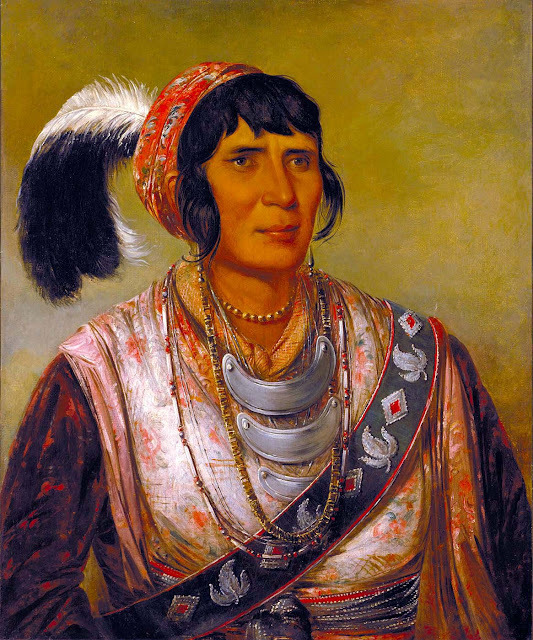
George Catlin - Seminole Chief Osceola (1838)
46 notes
·
View notes
Text
The American bison (Bison bison; pl.: bison), also called the American buffalo or simply buffalo (not to be confused with true buffalo), is a species of bison native to North America. It is one of two extant species of bison, alongside the European bison. Its historical range, by 9000 BCE, is described as the great bison belt, a tract of rich grassland that ran from Alaska to the Gulf of Mexico, east to the Atlantic Seaboard (nearly to the Atlantic tidewater in some areas), as far north as New York, south to Georgia, and according to some sources, further south to Florida, with sightings in North Carolina near Buffalo Ford on the Catawba River as late as 1750.
Once roaming in vast herds, the species nearly became extinct by a combination of commercial hunting and slaughter in the 19th century and introduction of bovine diseases from domestic cattle. With an estimated population of 60 million in the late 18th century, the species was culled down to just 541 animals by 1889 as part of the subjugation of the Native Americans, because the American bison was a major resource for their traditional way of life (food source, hides for clothing and shelter, and horns and bones for tools). Recovery efforts expanded in the mid-20th century, with a resurgence to roughly 31,000 wild bison as of March 2019. For many years, the population was primarily found in a few national parks and reserves. Through multiple reintroductions, the species now freely roams wild in several regions in the United States, Canada and Mexico. American Bison have also been introduced to Yakutia in Russia.
Two subspecies or ecotypes have been described: the plains bison (B. b. bison), smaller in size and with a more rounded hump, and the wood bison (B. b. athabascae)—the larger of the two and having a taller, square hump. Furthermore, the plains bison has been suggested to consist of a northern plains (B. b. montanae) and a southern plains (B. b. bison) subspecies, bringing the total to three. However, this is generally not supported. The wood bison is one of the largest wild species of extant bovid in the world, surpassed only by the Asian gaur. Among extant land animals in North America, the bison is the heaviest and the longest, and the second tallest after the moose.
Spanning back millennia, Native American tribes have had cultural and spiritual connections to the American bison. It is the national mammal of the United States.
George Catlin (July 26, 1796 – December 23, 1872) was an American lawyer, painter, author, and traveler, who specialized in portraits of Native Americans in the American frontier. Traveling to the American West five times during the 1830s, Catlin wrote about and painted portraits that depicted the life of the Plains Indians. His early work included engravings, drawn from nature, of sites along the route of the Erie Canal in New York State. Several of his renderings were published in one of the first printed books to use lithography, Cadwallader D. Colden’s Memoir, Prepared at the Request of a Committee of the Common Council of the City of New York, and Presented to the Mayor of the City, at the Celebration of the Completion of the New York Canals, published in 1825, with early images of the City of Buffalo.
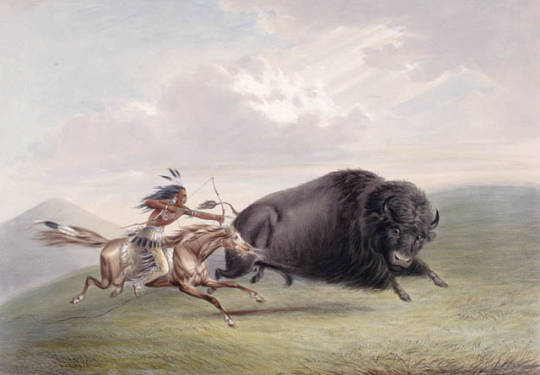
George Catlin, "Buffalo Hunt", 1844.
30 notes
·
View notes
Text
George Catlin (July 26, 1796 – December 23, 1872) was an American lawyer, painter, author, and traveler, who specialized in portraits of Native Americans in the American frontier. Traveling to the American West five times during the 1830s, Catlin wrote about and painted portraits that depicted the life of the Plains Indians. His early work included engravings, drawn from nature, of sites along the route of the Erie Canal in New York State. Several of his renderings were published in one of the first printed books to use lithography, Cadwallader D. Colden’s Memoir, Prepared at the Request of a Committee of the Common Council of the City of New York, and Presented to the Mayor of the City, at the Celebration of the Completion of the New York Canals, published in 1825, with early images of the City of Buffalo.
Catlin was born in 1796 in Wilkes-Barre, Pennsylvania. While growing up, George encountered "trappers, hunters, explorers and settlers who stayed with his family on their travels west." Catlin was also intrigued by stories told to him by his mother, Polly Sutton, who had been captured by Indians during the 1778 Battle of Wyoming in Pennsylvania. Like his father, Catlin trained at Litchfield Law School when he was 17, although he disliked the field of law. He was admitted to the Bar in 1819 and practiced law for two years before giving it up to travel and study art.
In 1823, he studied art in Philadelphia and became known for his work as a portraitist. After a meeting with "tribal delegation of Indians from the western frontier, Catlin became eager to preserve a record of Native American customs and individuals."
Catlin began his journey in 1830 when he accompanied Governor William Clark on a diplomatic mission up the Mississippi River into Native American territory. St. Louis became Catlin's base of operations for five trips he took between 1830 and 1836, eventually visiting fifty tribes. Two years later he ascended the Missouri River more than 3000 km (1900 miles) to Fort Union Trading Post, near what is now the North Dakota-Montana border, where he spent several weeks among indigenous people who were still relatively untouched by European culture. He visited eighteen tribes, including the Pawnee, Omaha, and Ponca in the south and the Mandan, Hidatsa, Cheyenne, Crow, Assiniboine, and Blackfeet to the north. There he produced the most vivid and penetrating portraits of his career. During later trips along the Arkansas, Red, and Mississippi rivers, as well as visits to Florida and the Great Lakes, he produced more than 500 paintings and gathered a substantial collection of artifacts.
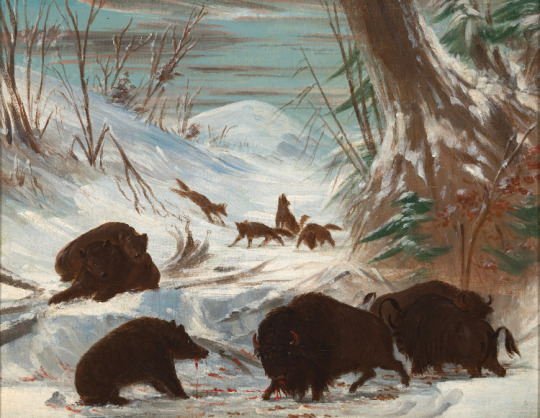
A Buffalo Stable Invaded by Grizzly Bears. George Catlin. 1852.
175 notes
·
View notes
Text
George Catlin (July 26, 1796 – December 23, 1872) was an American lawyer, painter, author, and traveler, who specialized in portraits of Native Americans in the American frontier. Traveling to the American West five times during the 1830s, Catlin wrote about and painted portraits that depicted the life of the Plains Indians. His early work included engravings, drawn from nature, of sites along the route of the Erie Canal in New York State. Several of his renderings were published in one of the first printed books to use lithography, Cadwallader D. Colden’s Memoir, Prepared at the Request of a Committee of the Common Council of the City of New York, and Presented to the Mayor of the City, at the Celebration of the Completion of the New York Canals, published in 1825, with early images of the City of Buffalo.

travels of George Catlins in North and Central America 1830-1855

George Catlin, Wa-ho-béck-ee, um Belo Guerreiro (1834)
26 notes
·
View notes
Text
George Catlin (July 26, 1796 – December 23, 1872) was an American lawyer, painter, author, and traveler, who specialized in portraits of Native Americans in the American frontier. Traveling to the American West five times during the 1830s, Catlin wrote about and painted portraits that depicted the life of the Plains Indians. His early work included engravings, drawn from nature, of sites along the route of the Erie Canal in New York State. Several of his renderings were published in one of the first printed books to use lithography, Cadwallader D. Colden’s Memoir, Prepared at the Request of a Committee of the Common Council of the City of New York, and Presented to the Mayor of the City, at the Celebration of the Completion of the New York Canals, published in 1825, with early images of the City of Buffalo.

Elk and Buffalo Grazing among Prairie Flowers, Texas, George Catlin, 1846-48
Oil on canvas
19 ⅝ x 27 ½ in. (49.7 x 70 cm)
Smithsonian American Art Museum, Washington, DC, USA
85 notes
·
View notes
Text
George Catlin (July 26, 1796 – December 23, 1872) was an American lawyer, painter, author, and traveler, who specialized in portraits of Native Americans in the American frontier. Traveling to the American West five times during the 1830s, Catlin wrote about and painted portraits that depicted the life of the Plains Indians. His early work included engravings, drawn from nature, of sites along the route of the Erie Canal in New York State. Several of his renderings were published in one of the first printed books to use lithography, Cadwallader D. Colden's Memoir, Prepared at the Request of a Committee of the Common Council of the City of New York, and Presented to the Mayor of the City, at the Celebration of the Completion of the New York Canals, published in 1825, with early images of the City of Buffalo.
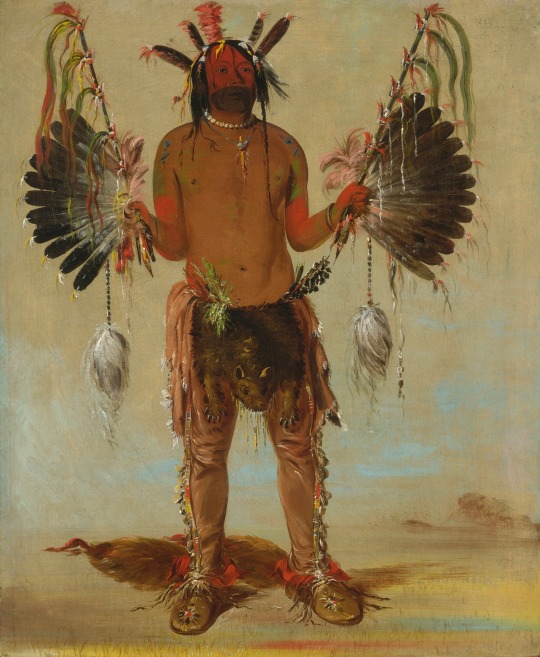
‘Mah-tó-he-ha, Old Bear, a Medicine Man’ by George Catlin, c. 1832.
129 notes
·
View notes
Photo
Alfred Jacob Miller (January 2, 1810 – June 26, 1874) was an American artist best known for his paintings of trappers and Native Americans in the fur trade of the western United States. He also painted numerous portraits and genre paintings in and around Baltimore during the mid-nineteenth century.
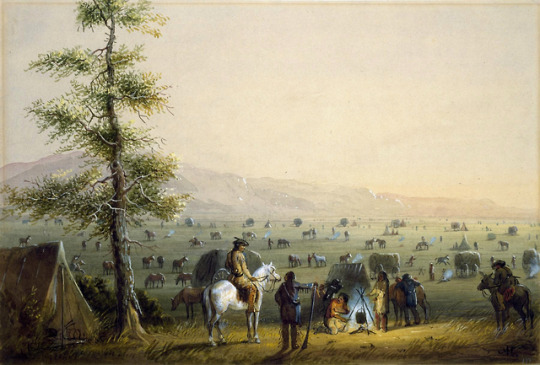
Our Camp, Alfred Jacob Miller (1810–1874)
[Public domain], via Wikimedia Commons
21 notes
·
View notes
Photo
Alfred Jacob Miller (January 2, 1810 – June 26, 1874) was an American artist best known for his paintings of trappers and Native Americans in the fur trade of the western United States. He also painted numerous portraits and genre paintings in and around Baltimore during the mid-nineteenth century.
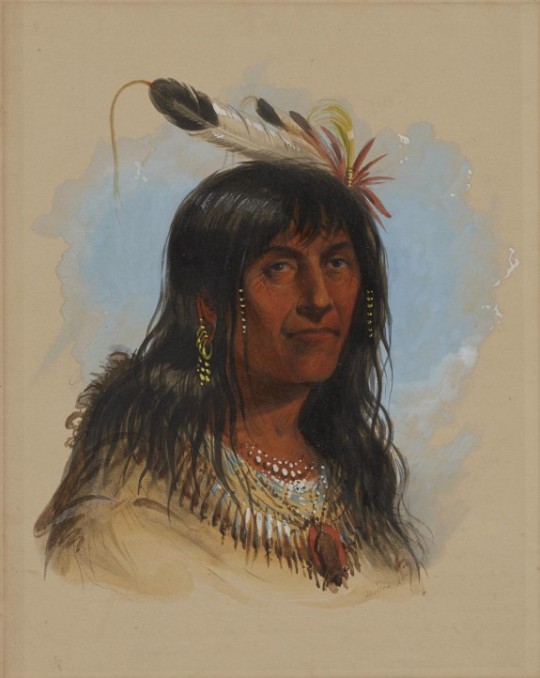
Big Bowl (A Crow Chief) - Alfred Jacob Miller, c. 1858
Watercolor heightened with white on paper, H: 11 15/16 x W: 9 ½ in. (30.3 x 24.1 cm)
“This [Big Bowl] is a translation from the Indian name by the interpreter, who signified to him that we preferred his profile instead of front view of his face; - to this he objected, we wished to learn the reason, and after some delay, he said that if I had only one side of his face, in case he was in battle, I might have the power of making that side sick; - evidently looking on me as a species of magician. The reasoning was not very satisfactory, but he was determined to have his own way, a three-quarter view was the result.” A.J. Miller, extracted from “The West of Alfred Jacob Miller” (1837). In July 1858 William T. Walters commissioned 200 watercolors at twelve dollars apiece from Baltimore born artist Alfred Jacob Miller. These paintings were each accompanied by a descriptive text, and were delivered in installments over the next twenty-one months and ultimately were bound in three albums. Transcriptions of field-sketches drawn during the 1837 expedition that Miller had undertaken to the annual fur-trader’s rendezvous in the Green River Valley (in what is now western Wyoming), these watercolors are a unique record of the closing years of the western fur trade. [x]
16 notes
·
View notes
Photo
Snake Indians is a collective name given to the Northern Paiute, Bannock, and Shoshone Native American tribes.
The term was used as early as 1739 by French trader and explorer Pierre Gaultier de Varennes, Sieur de la Verendrye when he described hearing of the Gens du Serpent ("Snake people") from the Mandans. This is probably the first written mention of the Shoshone people. The term "Snakes" is also used to refer to the Shoshone by British explorers David Thompson and Anthony Henday.
The term was also used by Plains Tribes to refer to the Shoshone. They called the Shoshone "snake" referring to the Shoshone sign in Plains Indian Sign Language for the Shoshone people. The sign was used for salmon but the fish was unknown on the Great Plains.
This term was widely used by American immigrants on the Oregon Trail in the Snake River and Owyhee River valleys of southern Idaho and Eastern Oregon. The term "Snake Indian" later included the Northern Paiute tribes found in the basins between the Cascade Mountains and these valleys in Oregon and northern Nevada and northeastern California. These people were the opponents of the California, Oregon and Washington Volunteers and U.S. Army, in the Snake War.
Alfred Jacob Miller (January 2, 1810 – June 26, 1874) was an American artist best known for his paintings of trappers and Native Americans in the fur trade of the western United States. He also painted numerous portraits and genre paintings in and around Baltimore during the mid-nineteenth century.

Ma-wo-ma, a 19th-century leader of approximately 3,000 Snake Indians, portrait by Alfred Jacob Miller .
14 notes
·
View notes
Photo
Alfred Jacob Miller (January 2, 1810 – June 26, 1874) was an American artist best known for his paintings of trappers and Native Americans in the fur trade of the western United States. He also painted numerous portraits and genre paintings in and around Baltimore during the mid-nineteenth century.

Camp Fire, Preparing the Evening Meal, 1858-60 by Alfred Jacob Miller (American, 1810–1874)
264 notes
·
View notes
Photo
Alfred Jacob Miller (January 2, 1810 – June 26, 1874) was an American artist best known for his paintings of trappers and Native Americans in the fur trade of the western United States. He also painted numerous portraits and genre paintings in and around Baltimore during the mid-nineteenth century.

Trappers Starting for the Beaver Hunt
[Le départ des trappeurs pour la chasse au castor]
Alfred Jacob Miller (1810–1874)
[Public domain], via Wikimedia Commons
22 notes
·
View notes